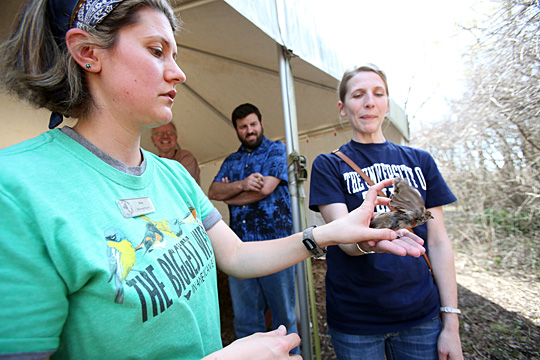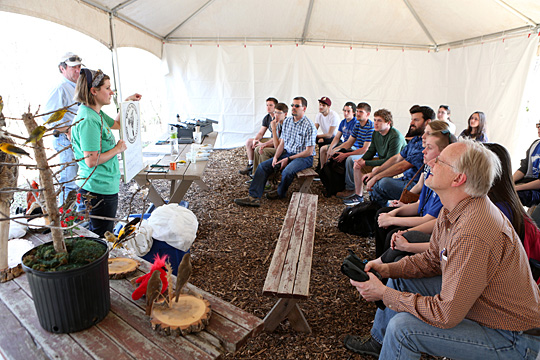As songbirds begin to stop, rest and refuel along Lake Erie marshes before finishing the last leg of their spring migration to Canada, a class of environmental science students at The University of Toledo learned firsthand how researchers collect data and what the long-term patterns teach about climate change.
“I had zero experience with birding,” UT senior Alexa Seaman said. “I heard this area is called the Warbler Capital of the World. Now I know why.”

Black Swamp Bird Observatory Research Director Mark Shieldcastle showed an American goldfinch to UT students before it was banded.
A group of 17 students boarded a bus last week on Main Campus for a 40-minute drive to the Black Swamp Bird Observatory at Magee Marsh State Wildlife Area in Ottawa County, which is preparing for the Biggest Week in American Birding, May 6-15. Tens of thousands of avid birders across the world flock to the 10-day festival timed to coincide with the peak of spring songbird migration.

Kate Zimmerman, the education director for the Black Swamp Bird Observatory, left, and UT student Jeanna Meisner released a banded American tree sparrow.
UT undergraduate students watched as conservation biologists at the observatory used mist-nets to carefully capture and care for the birds. Researchers demonstrated how to safely hold the birds, identify the species, and assess them for weight and condition.
“We were looking for the wing length, if it was male or female, and the amount of fat on the body,” Seaman said. “Before we released the birds, we also watched the banding process.”
According to Gottgens, researchers put a miniscule aluminum band around the leg of a bird to help track its travel.

Black Swamp Bird Observatory Education Director Kate Zimmerman spoke to students from Dr. Hans Gottgens’ upper-level conservation biology course.
The database on the conservation status of songbirds also provides information related to changes in the environment.
“By following the birds and relating it to climate conditions, you get an idea of how climate change affects bird migration,” Gottgens said. “Some birds might show up much later than they did 25 years ago partly because of change in the weather and climate conditions.”
Seaman had the opportunity to touch and release a warbler after a conservation biologist finished banding it.
“She placed the little bird on my hand, and the bird just flew away in a matter of seconds,” Seaman said. “It was an awesome, amazing experience.”